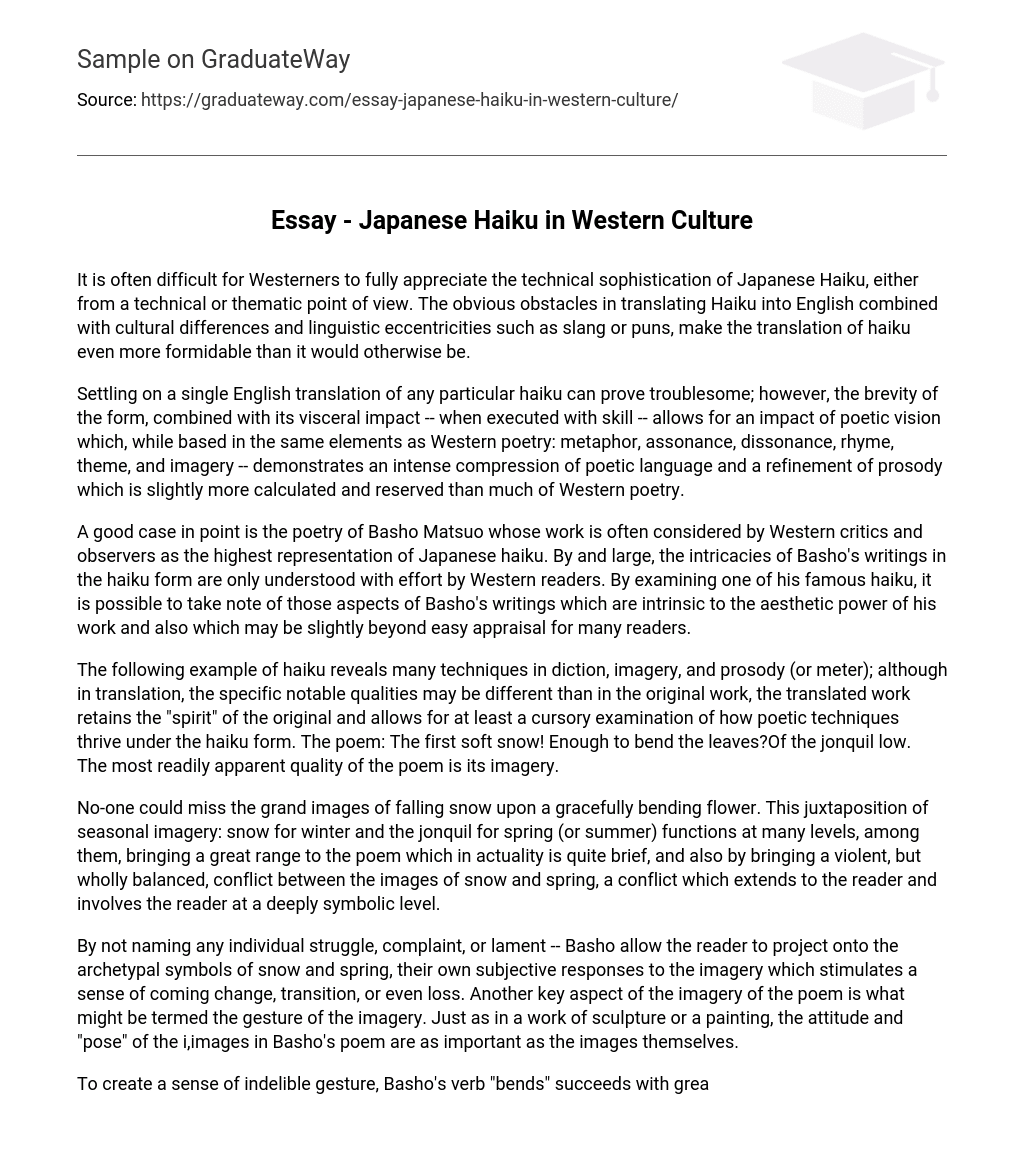The technical sophistication of Japanese Haiku, whether from a technical or thematic perspective, is challenging for Westerners to fully grasp. The translation of Haiku into English is particularly difficult due to obstacles such as cultural differences, linguistic eccentricities like slang or puns, and the inherent challenge of translation itself.
Choosing one specific English translation of a haiku can be difficult. However, the haiku’s concise nature and its ability to create a powerful emotional effect through skillful execution allow for a poetic vision that shares similarities with Western poetry, such as the use of metaphor, assonance, dissonance, rhyme, theme, and imagery. Yet, the haiku also showcases a unique ability to compress poetic language and display a more restrained and deliberate approach to prosody compared to many Western poems.
A noteworthy example is the poetry of Basho Matsuo, whose work is frequently regarded by Western critics and observers as the quintessential portrayal of Japanese haiku. In general, Western readers may encounter difficulty in fully grasping the complexities of Basho’s writings in the haiku form. By closely analyzing one of his famous haiku, one can identify the elements of Basho’s writing that contribute to the profound beauty of his work, yet may prove challenging for many readers to fully comprehend.
The given haiku exemplifies various techniques in choosing words, creating images, and maintaining a specific rhythm; while the noteworthy qualities might slightly differ when translated, the translated version preserves the essence of the original and facilitates a brief exploration of how poetic techniques flourish within the haiku structure. The poem: The initial gentle snowfall! Adequate to cause the bending? Of the low jonquil’s leaves. The most prominent feature of the poem is its vivid imagery.
The presence of both snow and a bending flower creates a striking contrast in the poem. The snow represents winter while the jonquil symbolizes either spring or summer. This combination adds depth and complexity to the poem, despite its brevity. Furthermore, it presents a conflicting yet harmonious relationship between the images of snow and spring. This conflict also extends to the reader, engaging them on a symbolic level.
By avoiding specific references to any individual forms of adversity, dissatisfaction, or sorrow, Basho invites the reader to attribute their own personal reactions to the universal symbols of snow and spring depicted in the poem. This evokes a feeling of impending transformation, change, or perhaps even grief. Additionally, the way the imagery is presented can be seen as significant. Similar to a sculpture or painting, the posture and “stance” of the images conveyed in Basho’s poem hold equal importance to the actual visuals portrayed.
To establish a lasting effect, Basho’s use of the verb “bends” not only effectively succeeds but also implies a harmonious surrender of opposing forces. It symbolizes the graceful submission of spring and winter, life and death, warmth and coldness, all encapsulated in the image of a gently bending flower that gracefully accepts the shift in seasons (and its inevitable demise in winter) with a delicate bow.
When reading the poem, the image of the jonquil can be seen as anthropomorphized to some extent. This invites the reader to imagine themselves in the poem’s scene, possibly viewing the jonquil as a symbol for themselves or for humanity’s response to nature’s changes. The gesture of the jonquil bowing to the snow signifies the interconnectedness of man and nature.
Basho used a unique form of figurative language to convey his profound message. The poem’s sound and prosody, along with its imagery and figurative language, deviate from traditional Western techniques. When spoken aloud, Basho’s haiku evokes a sense of enlightened wonder and insight.
Despite its brevity, the poem demonstrates reflectiveness through the alliteration of “soft snow” and the mention that it is the “first” snow. This alliteration continues with the word “leaves,” linking the images of snow and tree-flowers through diction and assonance. Additionally, the haiku’s abbreviated prosody enables a conversational delivery, as if conveying a profound understanding of both one’s own being and nature in general through ordinary conversation.
Basho uses plain language and powerful archetypal imagery to give the haiku form a wide and deep quality that its short length, strict meter, and theme might not achieve as elegantly or precisely in other hands. The word “low,” which ends the poem and also rhymes with “snow” in translation, symbolizes a harmonious bond with nature and an acceptance of its mysterious nature.
The jonquil bows in reverence to the heavenly “snow” and the vastness of the universe. This simple act is a symbol of nature’s embrace. The haiku’s use of an effortless, casual style highlights the interconnectedness of the cosmic and individual, the deep and trivial, and the poetic and everyday. This fusion is inherent in the haiku form.





